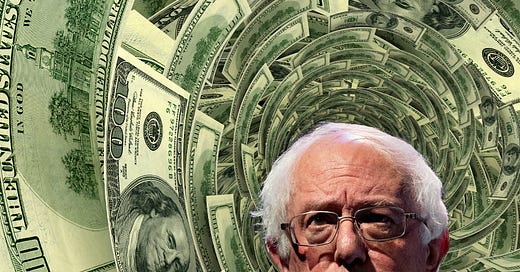
Bernie's Trillions
Are Democrats going to nominate a guy whose big plan is something so financially ridiculous that everyone already knows it can't happen?
Let's stipulate the profound unseriousness of a Republican party that has morphed into a Trumpist cult. But the Democrats have pretensions; they want us to believe they are the serious party, the party of grownups.
Would a serious party nominate Bernie Sanders?
And here I am not talking about his proto-Marxism, his ranty-old-man-yelling-at-the-sky persona, or his fascination with authoritarians (a track record extensively documented in this Washington Post piece.)
The real problem with Sanders is his policy platform, which even his fans seem to suspect is the stuff of fevered fantasies and fiscal unicorns. Outside of the Bernie Bros themselves, the best case for Sanders is that his proposals are so lavishly extreme that there is little or no chance they will ever be adopted.
In other words: The implausibility of his ideas is actually the selling point.
Perhaps that explains why none of his Democratic rivals have seemed especially interested in pushing Sanders to show how his math works. Spoiler: They know it doesn't. Hell, even Bernie knows it doesn't work. So his fellow Democrats gave him a pass, yet again, on Tuesday night.
The result of their passivity at the South Carolina debate, writes Ron Brownstein in the Atlantic was that "the blustery and disorderly session once again failed to fully explore what could be the Vermont senator’s greatest general-election weakness: the massive size and scope of his spending and tax proposals, which, depending on the estimate, would cost $50 trillion to $60 trillion over the next 10 years."
Sanders’ proposals, notes Brownstein, "would roughly double the size of the federal government, an unprecedented increase outside of wartime."
On the eve of the debate, Sanders released a document that purported to detail how he would pay for all of the free stuff he is promising—Medicare for All, College for All, Canceling Student Debt, Housing For All, Universal Childcare/Pre-K, Eliminating Medical Debt, Increasing Social Security, and the Green New Deal.
The numbers did not even come close to adding up.
As Brownstein notes: Sanders has also proposed "other expensive spending plans that he did not list, notably: increased funding for K–12 education, which has been estimated to cost $800 billion to $1 trillion; a federally funded paid-medical-and-family-leave program for workers, which the Congressional Budget Office recently scored at about $500 billion over a decade; a $1 trillion infrastructure initiative; and a federal guaranteed-jobs program whose cost estimates vary widely but that could run into the trillions."
Depending on which numbers you use, this raises federal spending somewhere around $50 to $60 trillion dollars over the next decade—or roughly double the current rate of spending. To pay for this, Sanders has proposed at least $30 trillion in new taxes on businesses and the rich, along with another $12 trillion in '"revenue and savings." Those tax hikes, Brownstein notes, "would increase federal taxes as a share of GDP by as much as 11 percentage points."
Sanders's tax hikes would be the largest peacetime increases in history. And they would inevitably hit the middle-class, hard.
But they would still not be enough. A fact-check by the Progressive Policy Institute’s Center for Funding America’s Future, found that Sanders' "pay-for" would still leave a massive $25 trillion hole:
Sanders’ proposed pay-fors don’t even come close to covering these costs. The document Sanders published last night, along with others released earlier in his campaign, claim to collectively raise less than $43 trillion in new revenue—meaning that he’s at least $10 trillion short. But the revenue projections Sanders uses for his tax proposals are well outside the mainstream of what independent analysts at the Committee for a Responsible Federal Budget, Congressional Budget Office, Tax Policy Center, Penn Wharton Budget Model, and others have estimated.
After reconciling Sanders’ latest list of pay-fors with these independent estimates, PPI concludes that even if Congress were to adopt every single revenue option Sanders has offered for consideration, it would fall almost $25 trillion short of his proposed spending increases over the next decade—leaving a gap nearly equal to the total value of all goods and services produced by the U.S. economy in one year. Brownstein quotes Jared Bernstein, an economist and senior fellow at the liberal Center on Budget and Policy Priorities, who admits: "You would need even more revenue than he is proposing to fully offset those costs. It is not realistic to believe you can get all those revenues from the top 1, 5, or 10 percent [of households]. You would have to go down further than that. The rest of it has to come from a broader base of taxpayers or it has to go on the deficit.”
But Bernstein insists that we need to take Sander's numbers seriously, but not literally. He says that Bernie's proposals are more “aspirational than realistic."
This, of course has become a familiar feature of our politics. Politicos who indulge in the politics of aspiration make “bold” proposals that they have no intention of actually enacting. Donald Trump claimed that he would build a big, beautiful wall and that Mexico would pay for it. Elizabeth Warren proposes a plan for everything and says that her new “wealth tax” will cover the tab. Bernie and the others embrace sweeping environmental schemes that are unconnected with reality.
And no one takes them literally. Of course. Because the fundamental unseriousness is baked in.
So now the question is whether the Democrats as a whole will embrace the mantle of fiscal frivolity, by nominating a man who is making promises that they know he can never possibly keep.





